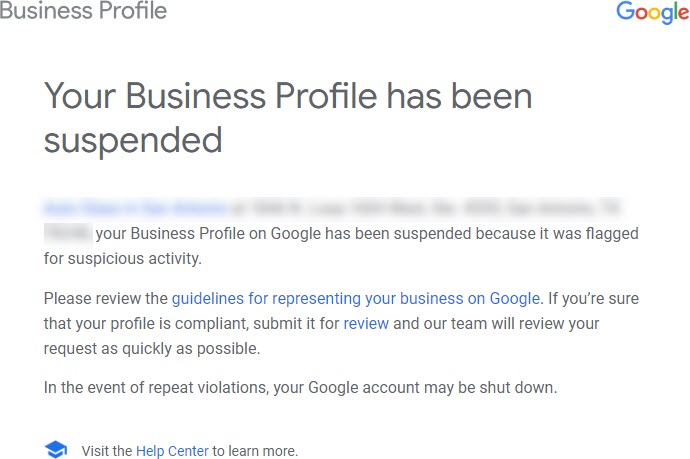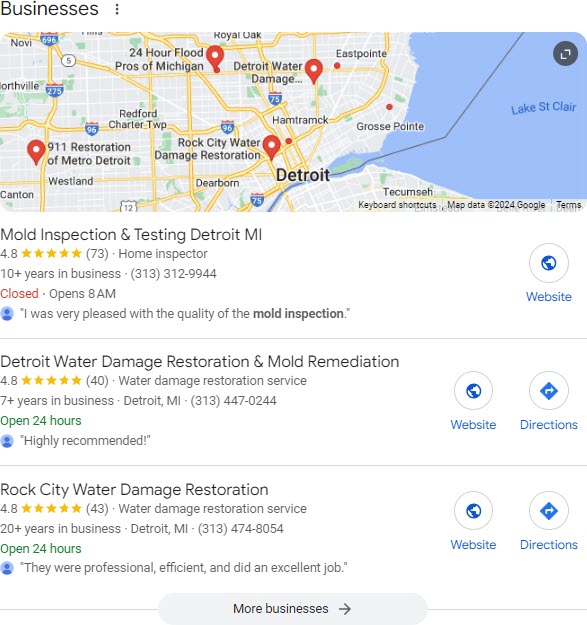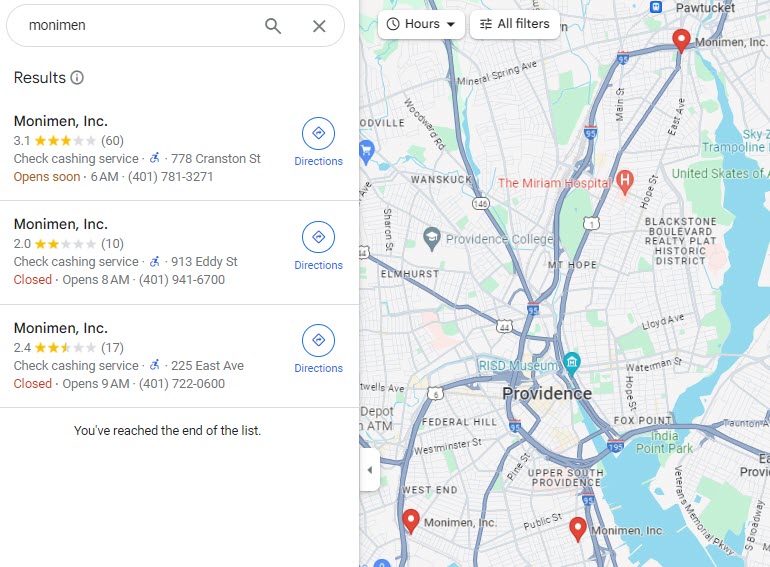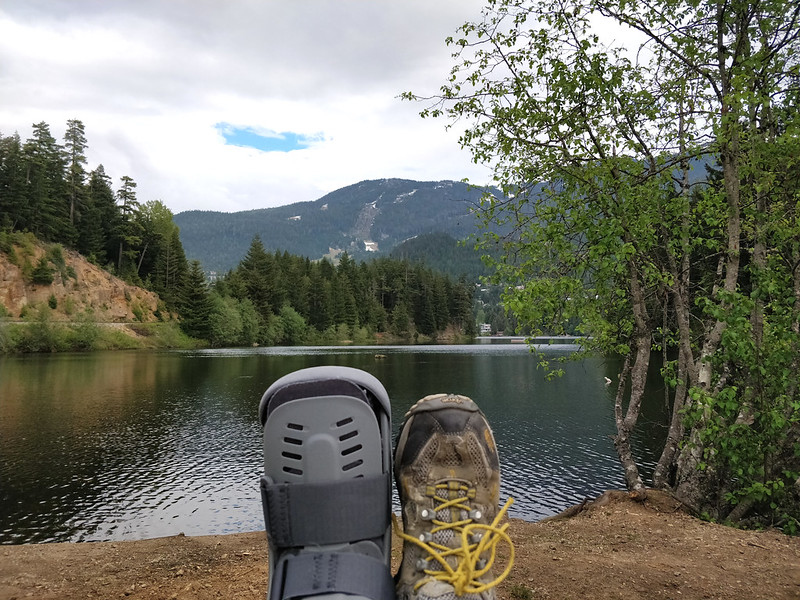If you break a leg, how long will you need to be in crutches, and how long before you can run? If you smash your pinky finger, when can you play Chopin again? If you throw out your back, how long until you can attempt a new personal record in the caber toss?
The answer, of course, is that it depends on what happened and on what you do about it. That’s also true in local SEO, both in the Google Maps results and in the organic results. What begins as a minor problem can fester, drag on forever, or become a fustercluck. What seems like a death knell may be just a wake-up call. If a specific problem is what’s holding you back and you fix it, sometimes you can start or resume ranking right away. If it’s a problem that takes you a long time to remedy, or even to discover, you’ll be in the paper gown for a while. If there’s no discernable problem, in which case you probably just haven’t put in enough work, your visibility may return very quickly or very slowly.
How do you determine that you have a problem, or exactly what the problem is, or when you’ve “recovered”? I’ve covered those questions (at least partially) in other posts, and will only dip a toe in the waters here. It’s easy to get carried away and make this post a Tolstoy novel.
What’s important is you know generally what you’re in for, in this or that situation. Otherwise, you’ll have even less of a sense of when your recovery is going fine or when it’s not, in which case you’re more likely to bungle the recovery or create new problems.
Here’s a rundown of some common (and less-common) mishaps that can hurt your local rankings, and roughly how long it will be before you’re back in the pink of health.
1. Google Business Profile hard-suspended (removed from Map): a few days to recover, once you’ve got your page reinstated. To do that, you’ll probably need to re-verify by video. After that, your Google Maps / 3-pack rankings likely will bounce right back to where they were.

What if your GBP page is soft-suspended (still showing on the map, but no longer in your control)? Your rankings won’t be affected, though your page is more likely to be removed if a competitor lobs a “suggest an edit” at you before you’ve re-verified your page.
2. Starting over with a new Google Business Profile page: variable recovery time, but likely to be at least a couple of weeks. When a GBP page is suspended or seemingly FUBAR, many business owners panic just create a new one, often out of panic. Occasionally that’s the right move, but usually it just complicates the situation. In any case, the new page tends not to rank for much for some time, unless maybe you’re in a very low-competition market or have an unusually powerful domain. Getting Google to transfer any reviews from the old page to the new page may expedite your return, though.
3. Filtered by a competitor who shares your address: instant recovery if you can get that competitor removed from Maps, or weeks or months to recover if you can’t. The latter situation is trickier, because in that case Google simply has deemed the competitor a better search result, for whatever reason(s). In that case, you may need to work on everything a little. The good news is that a super-close-by competitor won’t affect your organic rankings in the meantime.
4. Outranked by a competitor with a fake or keyword-stuffed Google Business Profile name: weeks-long recovery time, typically. Even if you get the name fixed or extraneous keywords removed, the competitor’s ill-gotten rankings will stick for a while before eventually petering out.

Of course, if it turns out that the address is also shady, you can send in a “suggest an edit” on the address at the same time you report the name, and Google may pull the page altogether. Murk your competitor like that and you’ll take care of two problems.
5. Rankings cratered after you moved your Google Business Profile to a new address: variable recovery time. If the move was extremely short (e.g. within a mile), you probably just need to update the address on your site and on your basic citation sources, and let it sit for a few weeks. If the move was farther AND you’re in a saturated market, there’s no telling how long your recovery will take, although it’s possible that you just stopped ranking in one place and started ranking in another place. If the move was farther and you’re in a rural or less-crowded market, recovery will probably take just a few days or maybe a couple of weeks, if you lost any Google Maps visibility at all.
6. Lost all or most Google reviews: weeks or months to recover, generally. This is a tough one, because Google reviews by themselves aren’t a huge driver of rankings, and there’s no telling exactly how much yours helped you or how helpful future reviews will be. (Reviews are critical for non-SEO reasons, of course.) But if you realize that even most removed Google reviews aren’t truly gone, you’ll try to get them back. If you can claw them back, your stay in the doghouse may be shorter. If you can’t and you need to get all-new Google reviews, assume that that process and your recovery will take many months.
7. Pelted with negative Google reviews: variable recovery time, though usually in the days-to-weeks range. In my experience, getting blasted with 1-star reviews (legit or bogus) tends not to affect Google Maps rankings, except in some extreme cases. You’re unlikely to see a drop right away, though. A barrage of 1-star and 2-star reviews is more likely to hurt your rankings if you have a long history of getting rough reviews.

If you can get a few of the bad reviews removed and rustle up a few good reviews from customers, you’re likely to shorten the recovery time or make it a non-issue. Your organic rankings won’t be affected at all by any of this, of course.
8. Site hacked, injected with malware, and filled with spammy pages: no downtime if you discover and clean up the malware immediately, or a months-long recovery if you don’t. If your site is down for more than a couple of days, and especially if thousands or millions of pages get indexed and sit around in Google’s index for more than a few days, it’ll probably take you months to get out of sickbay. A hack hobbles your organic visibility more than your Maps visibility. Both will be affected, but your Maps visibility will probably bounce back more quickly after a hack than your organic rankings will.
9. Pages de-indexed after a server error or registrar problem: a few days to recover if you fix the issue right away, or weeks or months if you don’t. The shorter the downtime, the shorter the recovery. The issue could be a crappy host, a rubber check for your hosting bill or domain renewal, a bad plugin (like a caching plugin), or a WordPress database-connection error. If you’re not sure what to do, at least camp out in Google Search Console and take in the data. I’ve found that Google is surprisingly forgiving of issues like those, presumably because just about everyone runs into one sooner or later. Some damage is inevitable.
10. Botched website redesign or migration, with URLs changed unnecessarily, 301-redirects mishandled, or internal links lost: weeks or months to recover. This is a rankings killer, especially in the organic results. How bad it will get depends on a lot of particulars. My general advice is: change your URLs as little as possible, and if you do change them, at least be bloody sure you 301-redirect the old URLs to their new homes. But even if you do that, you also need to make sure your developer keeps your internal links the same. Not only do you need to sniff out and fix any broken internal links, but you also need to make sure all menu, footer, and in-line links point to the same pages they used to point to. Keep your eyes peeled.
11. Wiped or radically different title tags: variable recovery time, but probably weeks. If you can flip your title tags back to what they were before Google re-indexes your pages, you probably won’t take a hit. Otherwise, assume it will be at least a few weeks before you can put away the crutches.
12. Page content removed or chopped dramatically: probably months to recover, at least if you’re in a competitive market. By removing a major reason your page ranked well, that whiz-kid developer just made your page or site into a eunuch. Bring back all of the removed content, blast it with internal links, get a few good backlinks you didn’t have before, and you might heal in good time.
13. Lost backlinks: months to recover. This is more of an issue for organic rankings than for the Google Maps 3-pack, but it affects both. Let’s say that through various efforts and the occasional stroke of luck you get lots of good links, from other sites to your site. Slowly but surely it helps your rankings, and you get busier, and you figure you’re done with that part of SEO, so you take your foot off the gas. You’ll be fine for a while – months or maybe years – but if you lose too many good links, your rankings will sputter. If you get those links back right away you’ll probably start heading in the right direction again. But it’ll probably take you months more of work on links and maybe on your on-page optimization to get back to where you were. The good news is that as you start to rebuild your links profile, some of your rankings will come back, and you may even get some visibility you didn’t have before. So you’ll benefit from a partial recovery before you see a fuller one.
14. Google Maps-specific algorithm update: days, weeks, or months. Exceedingly variable. Most of the time, Google makes proximity (i.e. the importance of your location) way less or way more important. In that case, your visibility may dry up indefinitely in one place and increase in another within days, but then it may take you months of work to get visible in both places (if that’s even possible). On the other hand, sometimes Google will botch an update, snuff out your rankings in the process, and days later tweak the update, causing your rankings to return. The best things you can do are to study Search Console, avoid making dramatic changes for a couple of weeks, and not fixate on the map at the expense of your overall visibility.
15. Algorithmic update that hit your organic rankings: months to recover. I’m referring to Google’s seemingly constant core updates and to the smaller updates with the crazy names. In my experience, these can mess up your organic visibility, but not your Google Maps visibility. Same with manual penalties, by the way.
—
The best recovery is the one you don’t have to make. A pint of sweat saves a gallon of blood. Focus on thick rankings and not just high rankings, study Search Console data before all other intel streams, work on your SEO long-term rather than in furious blasts, spend as much time on trying to convert local searchers as you do on trying to flash before their screens. If you do those things, you’ll head off most or all disasters at the pass and you won’t care much about recovery times anymore. Rather than limping around, you can finally get some air.
What’s a problem you ran into, and how long did it take you to get out of it? Any surprises? Bits of advice? Leave a comment!




Recent Comments